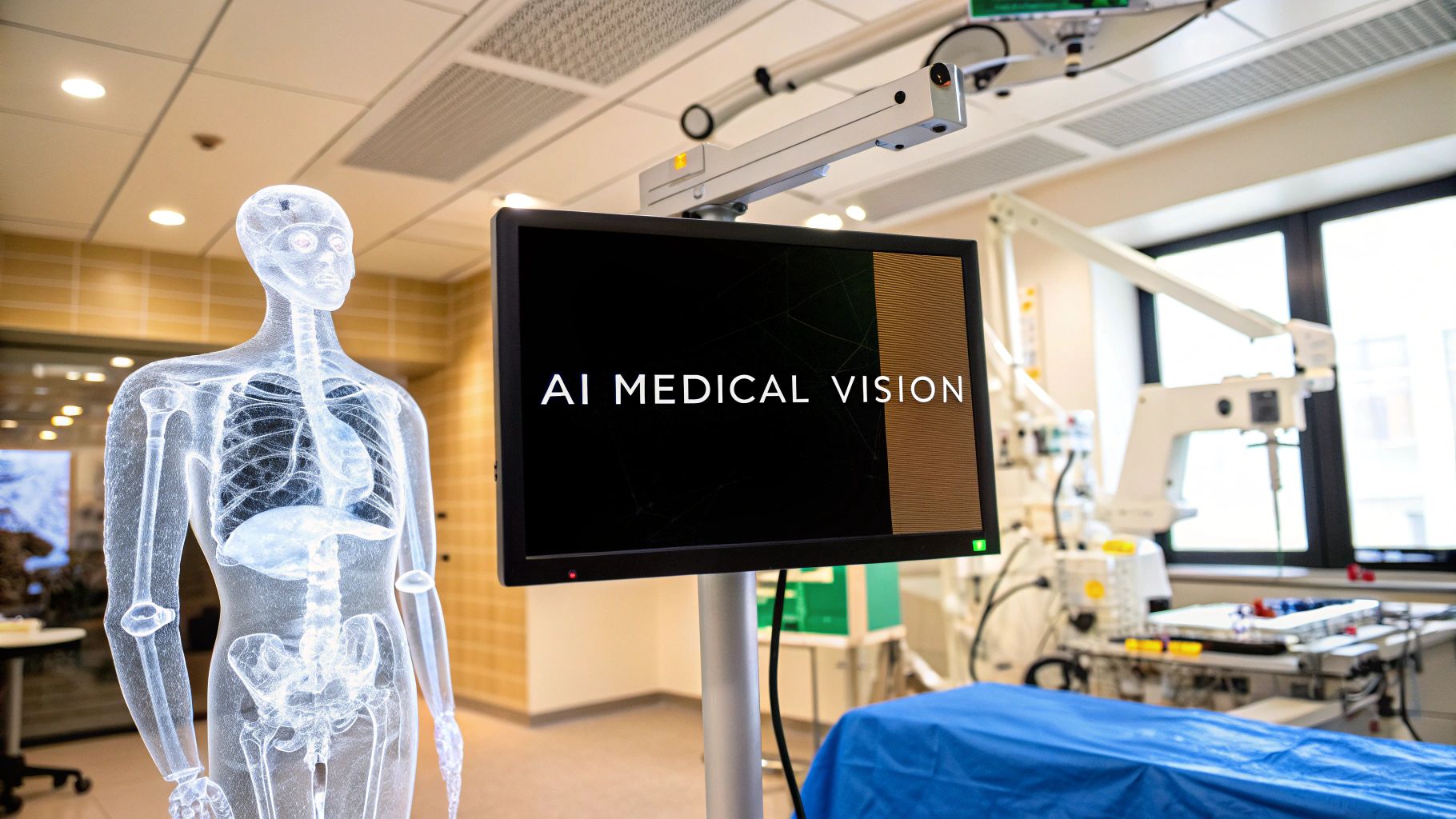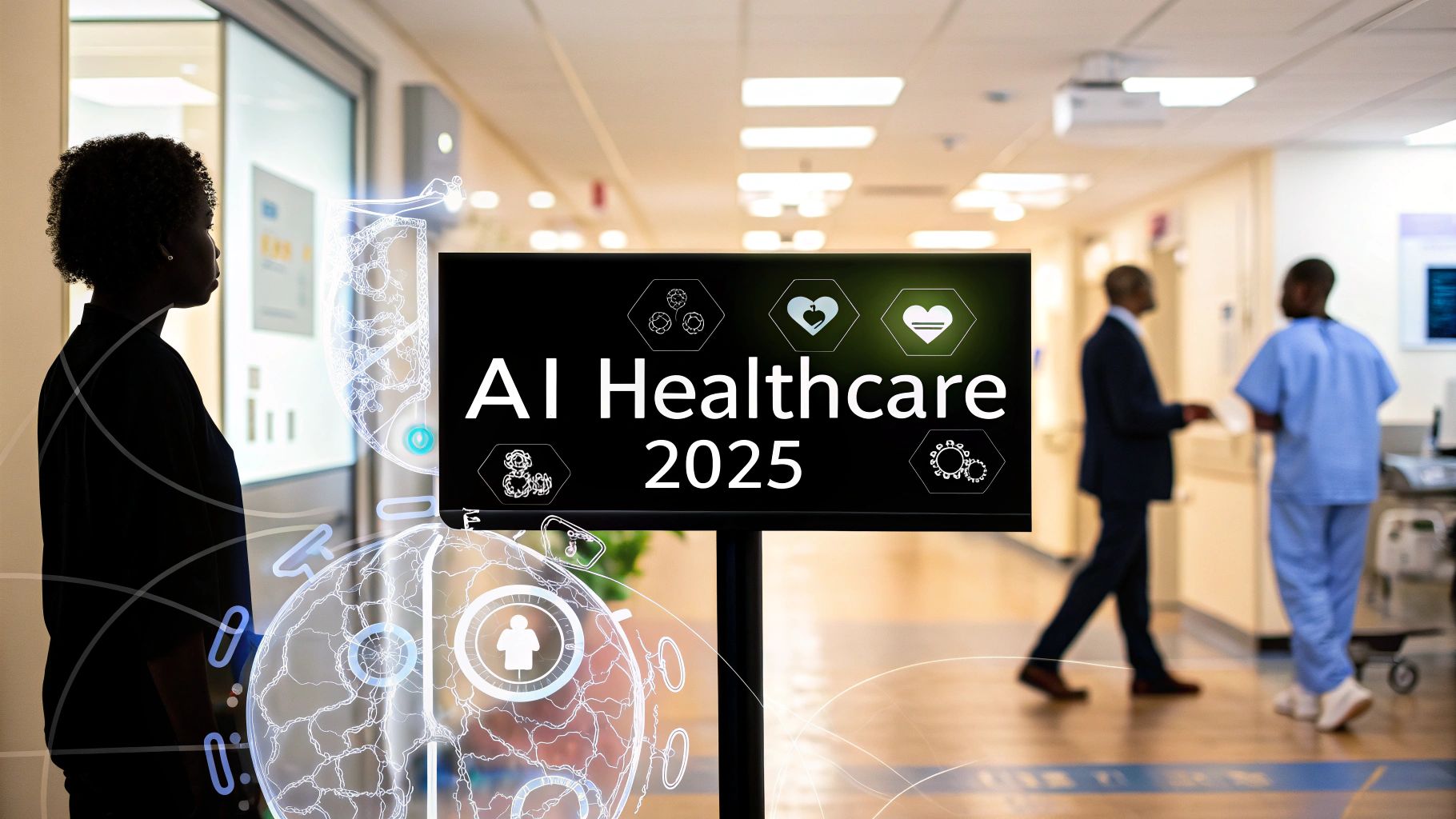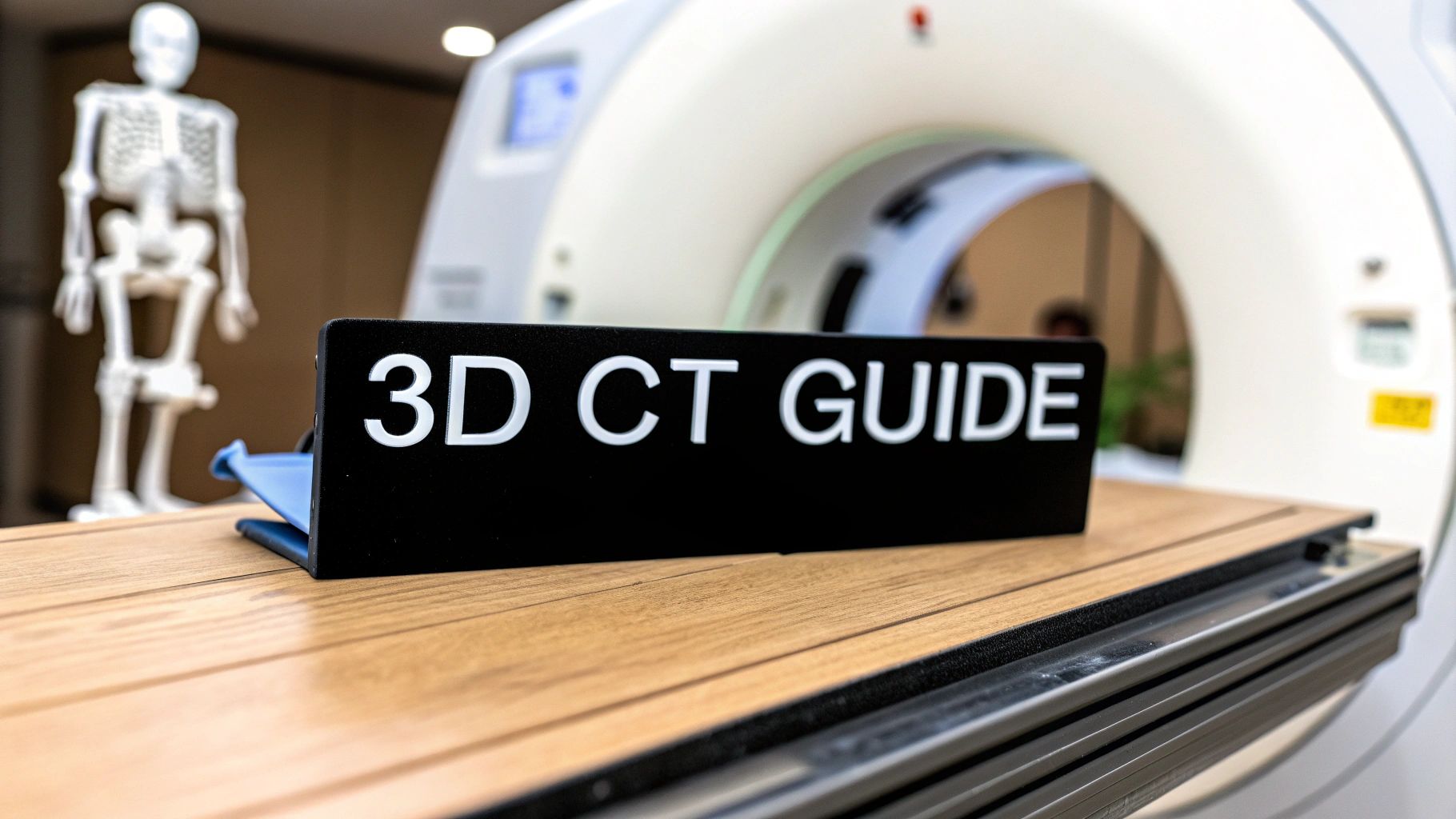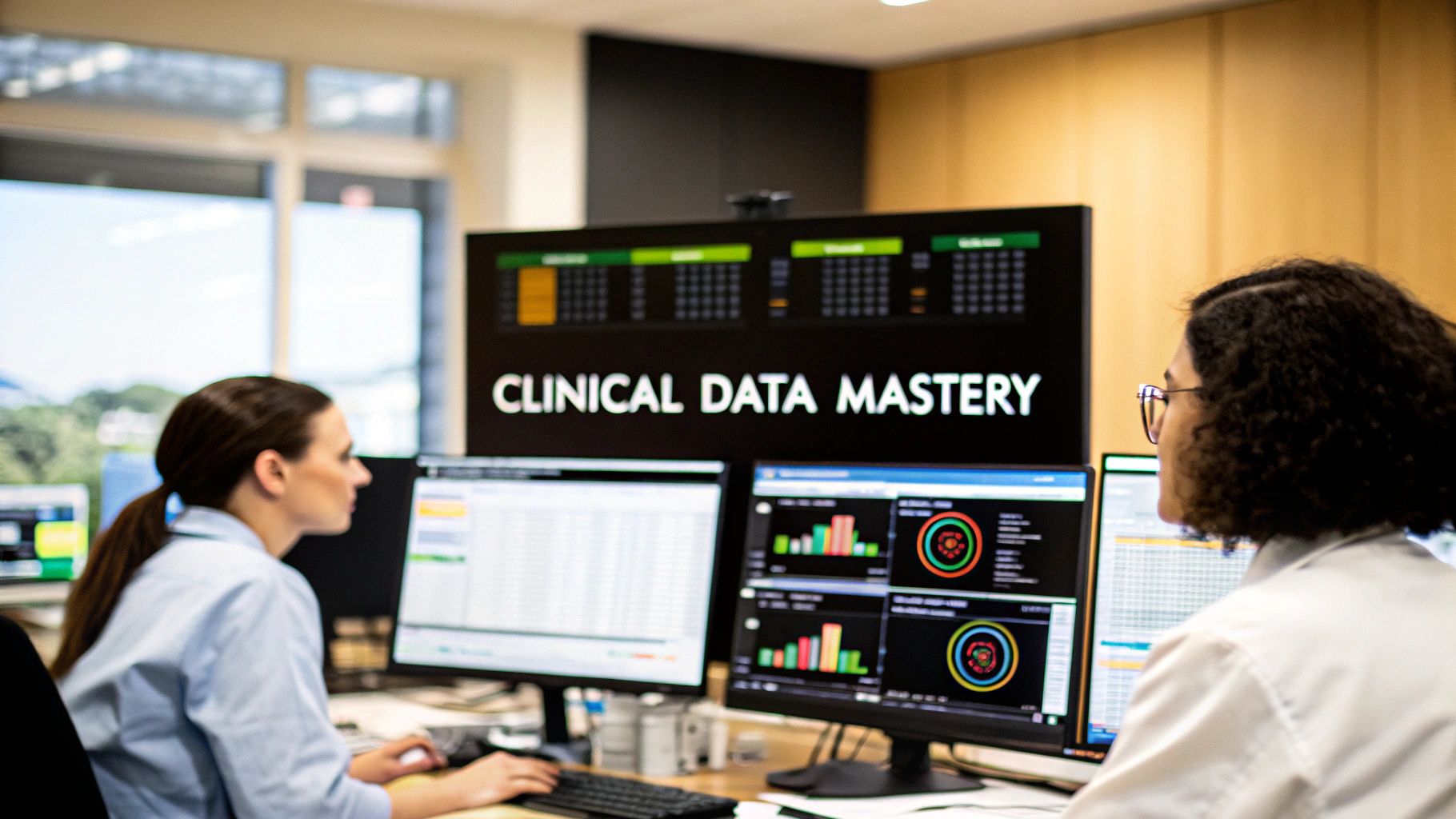The Future of Healthcare is Here
This listicle explores seven key applications of computer vision in healthcare, demonstrating how this technology is transforming patient care and medical practices. Learn how computer vision improves medical image analysis and diagnostics, enhances surgical navigation, accelerates drug discovery, enables remote patient monitoring, assists in pathology, detects skin cancer, and identifies eye diseases. These advancements offer significant potential for improved accuracy, efficiency, and ultimately, better patient outcomes. Understanding these applications is crucial for staying competitive and delivering innovative healthcare solutions.
1. Medical Image Analysis and Diagnostics
Medical image analysis and diagnostics represents a revolutionary application of computer vision in healthcare. This technology leverages sophisticated algorithms, particularly deep learning models, to analyze medical images like X-rays, CT scans, MRIs, and mammograms. By identifying patterns often invisible to the human eye, computer vision provides consistent and rapid analysis, assisting clinicians in detecting abnormalities, making diagnoses, and obtaining quantitative measurements. This powerful tool holds the potential to transform healthcare by enhancing diagnostic accuracy, accelerating results, and improving patient outcomes.
Computer vision algorithms achieve this by processing vast datasets of labeled medical images. These datasets "train" the algorithms to recognize specific features and patterns associated with various diseases and conditions. For instance, a deep learning model can be trained to differentiate between cancerous and non-cancerous tissues in a mammogram or to detect micro-bleeds in a retinal scan indicative of diabetic retinopathy. The trained models then analyze new images, flagging potential abnormalities and providing quantitative data for clinical review.
The benefits of incorporating computer vision into medical image analysis are manifold. This technology offers:
- Automated Pattern Recognition: Algorithms can identify subtle patterns and anomalies that might be missed by human observers, leading to increased diagnostic accuracy.
- Quantitative Analysis and Measurement Tools: Precise measurements of anatomical structures and lesions provide valuable data for treatment planning and monitoring disease progression.
- Multi-modal Image Fusion: Integrating data from multiple imaging modalities, such as CT and MRI, can provide a more comprehensive view of a patient's condition.
- Real-time Processing and Analysis: Rapid analysis of medical images enables faster diagnosis and treatment decisions, especially crucial in time-sensitive situations like stroke detection.
- Integration with PACS: Seamless integration with Picture Archiving and Communication Systems streamlines workflow and facilitates efficient image management.
Several successful implementations demonstrate the transformative power of this technology. Google's AI has shown remarkable accuracy in detecting diabetic retinopathy in retinal photographs, potentially preventing blindness in millions. Zebra Medical Vision uses AI to analyze CT scans for various conditions, including bone density assessment and cardiovascular disease detection. Aidoc provides AI-powered solutions for rapidly identifying critical conditions like stroke and pulmonary embolism, enabling faster intervention. IBM Watson for Oncology assists oncologists in making informed cancer treatment decisions.
However, it's crucial to acknowledge the limitations and challenges associated with computer vision in medical imaging:
- Extensive Training Data and Validation: Developing robust and reliable algorithms requires large, diverse, and high-quality datasets, which can be challenging and expensive to acquire.
- False Positives/Negatives: Like any diagnostic tool, computer vision algorithms can produce false positives or negatives, potentially leading to unnecessary procedures or missed diagnoses. Human oversight remains essential.
- Regulatory Approval Processes: Navigating regulatory pathways for AI-powered medical devices can be complex and time-consuming.
- High Initial Implementation Costs: Integrating computer vision technology into existing healthcare systems requires significant upfront investment.
- Potential for Over-Reliance: Over-reliance on technology without critical human evaluation can lead to diagnostic errors.
To maximize the benefits and mitigate the risks of computer vision in medical image analysis, consider the following:
- Ensure Diverse and Representative Training Datasets: Algorithms trained on diverse datasets are less likely to exhibit bias and perform more reliably across different patient populations.
- Implement Robust Validation Protocols: Rigorous validation is essential to ensure the accuracy and reliability of computer vision algorithms.
- Maintain Human Oversight and Final Decision-Making: Clinicians should always retain the final decision-making authority, using computer vision as a tool to augment their expertise.
- Regular Model Updates and Retraining: Medical knowledge and imaging techniques constantly evolve, necessitating regular updates and retraining of algorithms to maintain optimal performance.
- Comply with Medical Device Regulations: Adherence to regulatory requirements, such as FDA approval, is crucial for ensuring patient safety and trust.
The following infographic visualizes key data points highlighting the power of computer vision in medical image analysis:
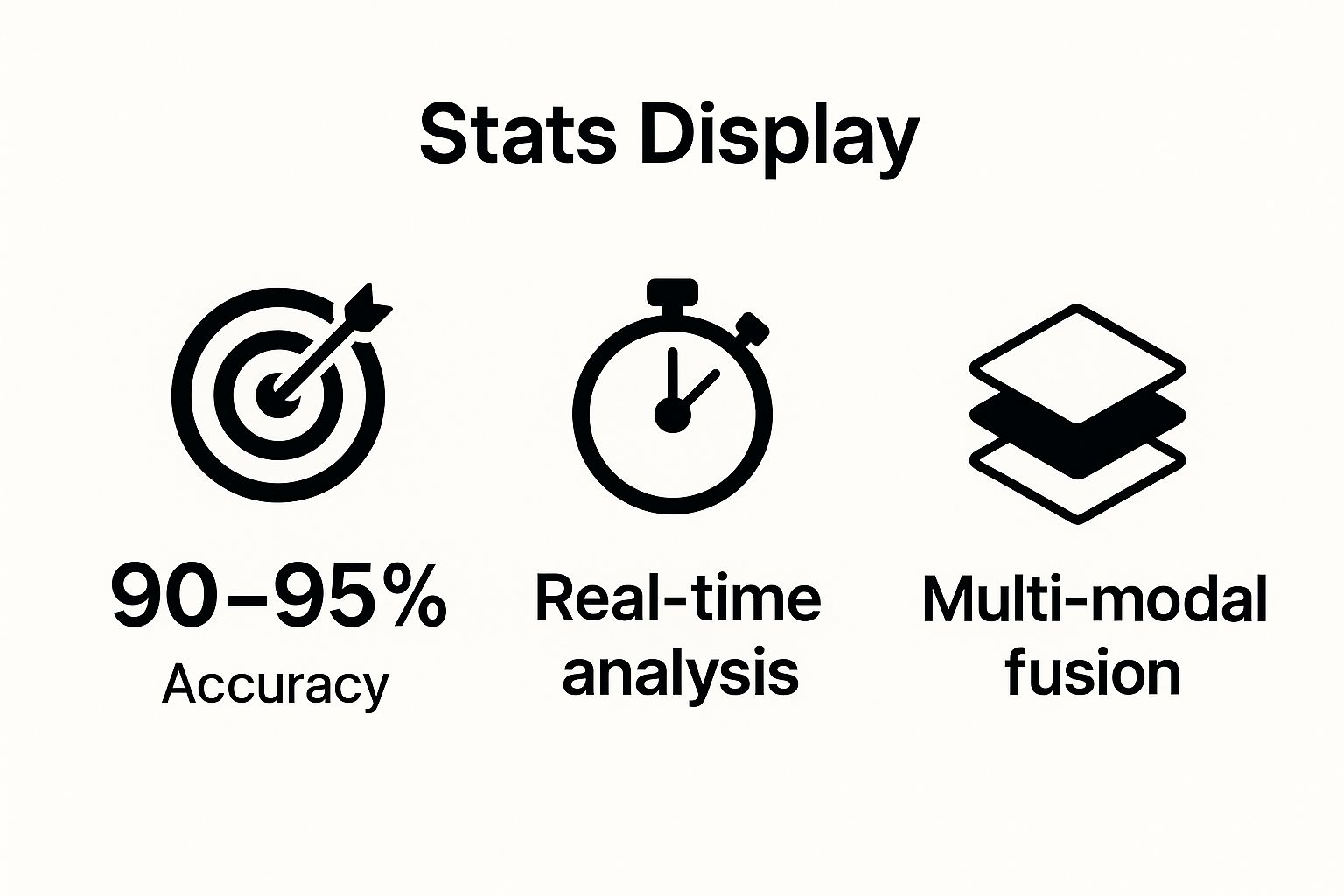
This infographic emphasizes the impressive accuracy rates (90-95%), real-time analysis capabilities, and the potential of multi-modal image fusion, all of which contribute to improved diagnostics and patient care. These statistics underscore the transformative impact of computer vision in medical imaging, enabling faster, more accurate, and more efficient diagnosis and treatment planning. When combined with human expertise, these technologies are poised to reshape the future of healthcare.
2. Surgical Navigation and Guidance
Computer vision in healthcare is revolutionizing surgical procedures, offering unprecedented levels of precision and control. Surgical navigation and guidance systems leverage computer vision to provide real-time, intraoperative assistance, transforming the operating room into a digitally enhanced environment. These systems work by processing images from various sources, such as endoscopic cameras, pre-operative CT scans, and MRI data. This information is then used to create a 3D model of the surgical site, which is overlaid with real-time tracking of surgical instruments. This augmented reality view provides surgeons with a detailed roadmap, enhancing their ability to navigate complex anatomical structures and perform intricate procedures with greater accuracy.
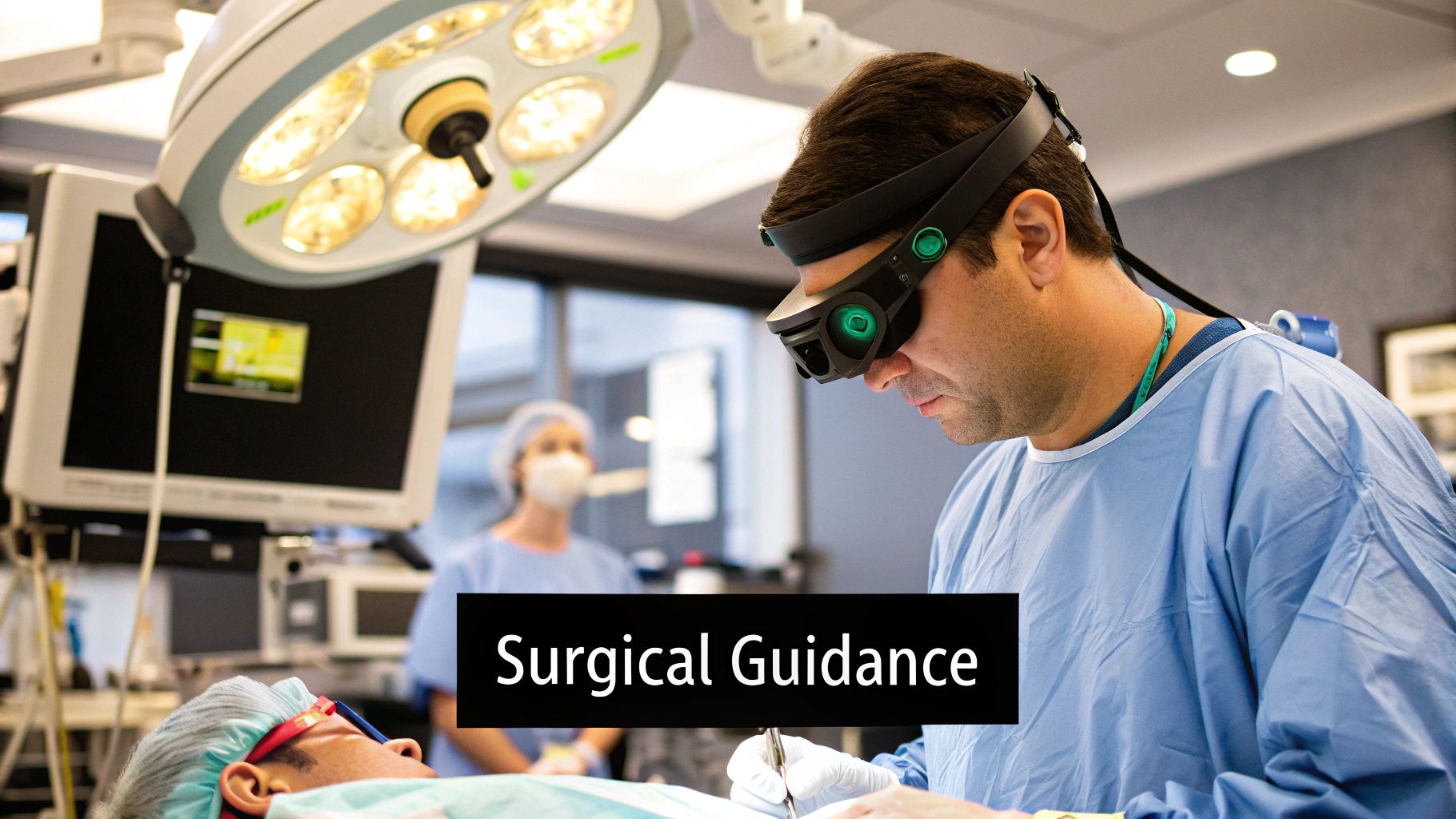
This technology empowers surgeons with features like real-time instrument tracking and positioning, 3D visualization and modeling of the surgical field, and augmented reality overlays that project critical information directly onto the patient. Furthermore, these systems can integrate with robotic surgical systems, further amplifying precision and control. Pre-operative planning capabilities allow surgeons to meticulously map out the procedure beforehand, optimizing surgical strategies and minimizing potential complications. This approach firmly secures its place within the top applications of computer vision in healthcare due to its transformative impact on surgical precision, patient safety, and surgical training.
Examples of successful implementations of surgical navigation and guidance systems include the da Vinci Surgical System by Intuitive Surgical, renowned for its minimally invasive robotic surgery capabilities; Medtronic's StealthStation navigation system, widely used in neurosurgery and spine surgery; Brainlab's surgical navigation platforms, offering a comprehensive suite of tools for various surgical specialties; and Augmedics' AR spine surgery guidance system, which provides surgeons with a "see-through" view of the patient's anatomy during spinal procedures.
The advantages of incorporating computer vision-assisted surgical navigation are manifold. Enhanced surgical precision and accuracy lead to reduced invasiveness, minimizing trauma and facilitating faster patient recovery times. Improved patient safety is a paramount benefit, with reduced risk of complications and improved surgical outcomes. These systems also provide better training opportunities for surgeons, allowing them to practice complex procedures in a simulated environment and refine their skills. Furthermore, surgical navigation systems contribute to the standardization of surgical procedures, promoting consistency and best practices across different surgical teams and institutions.
However, several challenges need to be addressed for wider adoption. The high cost of implementation can be a significant barrier for some healthcare facilities. Surgical teams require extensive training to effectively utilize these advanced systems, representing a learning curve that demands time and resources. Potential technical failures during surgery, although rare, necessitate robust backup procedures and contingency plans. Currently, the application of these systems is often limited to specific types of procedures, and their performance is dependent on the availability of high-quality imaging data.
To maximize the benefits of surgical navigation and guidance systems, several actionable tips are crucial. Comprehensive training programs for surgical teams are essential to ensure proficiency and safe operation. Regular system calibration and maintenance are vital to maintain accuracy and reliability. Establishing robust backup procedures in case of system failure is critical to ensure patient safety. Seamless integration with existing hospital infrastructure, including electronic health records and imaging systems, streamlines workflows and optimizes data management. Continuous monitoring of surgical outcomes is essential to assess the effectiveness of the technology and identify areas for improvement.
When considering implementing computer vision-based surgical navigation, assess the specific needs of your surgical department and the types of procedures performed. These systems are particularly beneficial for complex minimally invasive surgeries requiring high precision and accuracy, such as neurosurgery, spine surgery, cardiac surgery, and orthopedic procedures. By carefully evaluating the benefits, challenges, and implementation requirements, healthcare providers can leverage the power of computer vision to transform surgical care and enhance patient outcomes.
3. Drug Discovery and Development
Computer vision in healthcare is revolutionizing numerous areas, and drug discovery and development is no exception. This innovative application leverages the power of artificial intelligence (AI) and image analysis to expedite the traditionally lengthy and costly process of bringing new drugs to market. By analyzing complex visual data, computer vision algorithms can identify potential therapeutic targets, screen compounds, predict drug interactions, and even optimize existing treatments with unprecedented efficiency. This makes it a crucial component in modern pharmaceutical research and earns it a prominent place on this list.
Traditional drug discovery relies heavily on laborious and time-consuming experimental methods. Computer vision offers a powerful alternative by allowing researchers to analyze vast amounts of biological and chemical data in a fraction of the time. At its core, this technology works by converting molecular structures, protein interactions, and other biological processes into visual representations that AI models can interpret and learn from. These models can then identify patterns and relationships that would be impossible for humans to detect, leading to faster and more effective drug discovery.
One crucial area where computer vision shines is molecular structure analysis and prediction. AI algorithms can analyze the intricate 3D structures of molecules to predict their properties and interactions with biological targets. This is particularly valuable in protein folding prediction, a notoriously complex challenge. Accurately predicting how proteins fold is essential for understanding their function and how they interact with potential drugs. DeepMind's AlphaFold, for instance, has achieved groundbreaking results in this area, demonstrating the potential of computer vision to unlock crucial insights into protein behavior.
Another key feature is high-throughput screening automation. Computer vision enables automated analysis of microscopic images of cells and tissues, allowing researchers to rapidly screen thousands of compounds for their potential therapeutic effects. This significantly accelerates the identification of promising drug candidates. Companies like Atomwise are using AI-powered platforms to screen vast libraries of small molecules, drastically reducing the time and cost associated with traditional screening methods.
Beyond identifying new drug candidates, computer vision plays a vital role in drug-target interaction modeling. By analyzing the interactions between drug molecules and their target proteins, AI models can predict the efficacy and potential side effects of a drug. This information is invaluable in optimizing drug design and minimizing the risk of adverse reactions. Toxicity and efficacy prediction are also significantly improved by computer vision, allowing researchers to identify potential safety issues early in the development process. Insilico Medicine, for example, utilizes computer vision and AI in their research on aging and cancer, accelerating the discovery of novel therapies and diagnostic tools.
The advantages of incorporating computer vision into drug discovery are substantial. It leads to a significant reduction in the drug discovery timeline and lowers research and development costs. Moreover, computer vision facilitates the identification of novel drug targets and an improved prediction of drug safety, ultimately leading to an enhanced understanding of disease mechanisms. BenevolentAI's drug repurposing platform leverages these advantages to identify existing drugs that can be repurposed for new indications.
However, there are challenges associated with this technology. The quality and availability of data are crucial for the success of computer vision models. Limited by quality of available data, the results can be skewed if the training data is incomplete or biased. Regulatory uncertainty for AI-discovered drugs also poses a challenge, as regulatory bodies are still developing frameworks for evaluating and approving drugs discovered using AI. The high computational requirements for training and running complex AI models can be a barrier for some research institutions. Furthermore, the difficulty in explaining AI decision-making can make it challenging to understand the rationale behind a particular drug discovery. Finally, extensive validation studies are necessary to ensure the accuracy and reliability of computer vision-based predictions.
For those looking to implement computer vision in their drug discovery efforts, several tips are crucial. Collaborate with academic institutions for data access to expand your data resources. Invest in high-quality, diverse datasets to train robust and reliable AI models. Maintain close collaboration between AI teams and chemists to bridge the gap between computational analysis and experimental validation. Implement robust validation protocols to ensure the accuracy and reproducibility of your findings. And lastly, stay updated with regulatory guidelines to navigate the evolving landscape of AI-driven drug development.
4. Patient Monitoring and Vital Signs Detection
Computer vision is revolutionizing healthcare, and one of its most impactful applications is in patient monitoring and vital signs detection. This technology allows for contactless and continuous monitoring of patients, extracting vital signs like heart rate, respiratory rate, and movement patterns through sophisticated video analysis. This eliminates the need for physical sensors in many scenarios, offering a more comfortable and less invasive approach to patient care. This is particularly valuable in intensive care units (ICUs), elderly care facilities, and remote patient monitoring settings.
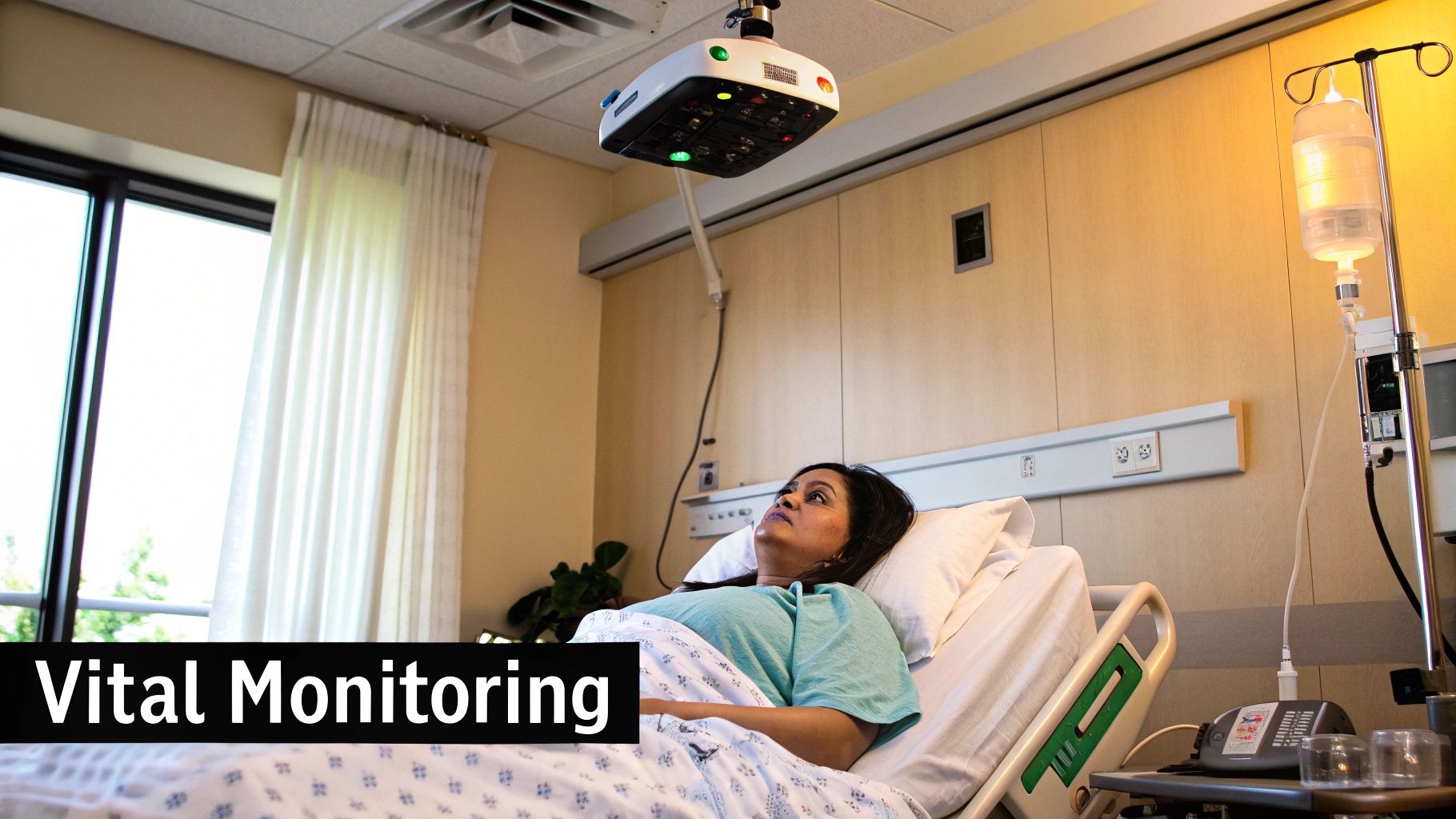
This technology works by analyzing subtle changes in video recordings of the patient. Algorithms are trained to detect minute variations in skin color caused by blood flow, which correlate with heart rate. Chest movements are tracked to determine respiratory rate. Furthermore, sophisticated motion analysis can detect patient movement and posture, enabling fall detection and even providing insights into sleep patterns. Some advanced systems are also exploring facial expression analysis to assess pain levels, offering a potential breakthrough for patients who struggle to communicate their discomfort.
The advantages of computer vision-based patient monitoring are numerous. It offers a non-invasive and comfortable experience for patients, eliminating the discomfort and potential skin irritation associated with traditional sensors. Continuous monitoring is possible without interruption, providing a constant stream of data for healthcare professionals. This approach also reduces the risk of infection associated with shared or improperly sanitized sensors. From a financial perspective, computer vision-based systems can be highly cost-effective for large-scale monitoring, particularly in settings with limited resources. Perhaps most importantly, it allows for early detection of health deterioration, enabling timely intervention and potentially improving patient outcomes.
Several companies are leading the way in developing and implementing this transformative technology. Philips' HealthSuite digital platform integrates computer vision for comprehensive patient monitoring, while Current Health offers a completely wearable-free monitoring solution. Biobeat Technologies provides contactless monitoring solutions leveraging AI, and EarlySense has developed innovative under-mattress monitoring systems that capture vital signs without any physical contact. These are just a few examples of the growing landscape of companies investing in this promising area of healthcare.
Despite the significant benefits, there are also challenges and limitations to consider. The accuracy of computer vision-based vital sign measurements can be affected by factors like lighting conditions and camera positioning. While generally comparable to traditional methods, the accuracy can be lower in certain circumstances compared to direct sensor measurements. Privacy concerns surrounding video monitoring are also a critical consideration, and robust safeguards must be implemented to protect patient confidentiality. Additionally, these systems can face difficulties with very sick or immobile patients, as subtle movements may be difficult to detect. Interference from medical equipment or other objects in the camera's view can also pose challenges.
To maximize the effectiveness and address the potential challenges of computer vision-based patient monitoring, several practical tips should be considered. Ensuring adequate and consistent lighting in the monitoring area is crucial. Careful camera positioning is essential to capture the necessary data while respecting patient privacy. Calibration of the systems for different patient populations, considering factors like age, skin tone, and underlying health conditions, is important to ensure accuracy. Seamless integration with existing hospital monitoring systems streamlines data flow and facilitates clinical decision-making. Finally, thorough training for staff on the interpretation of AI-generated alerts is essential to ensure appropriate and timely responses.
Computer vision in healthcare is rapidly evolving, and patient monitoring and vital signs detection represent a crucial application of this technology. Its potential to enhance patient care, improve outcomes, and increase efficiency makes it a vital area of development for medical device manufacturers, healthcare technology companies, and medical researchers alike. By understanding the benefits, limitations, and best practices for implementation, healthcare providers can leverage the power of computer vision to transform the way patients are monitored and cared for.
5. Pathology and Histological Analysis
Computer vision in healthcare is revolutionizing numerous fields, and pathology is no exception. Pathology and histological analysis, traditionally reliant on manual microscopic examination of tissue samples, are being transformed by AI-powered computer vision. This technology allows for automated analysis of tissue samples, identification of cellular abnormalities, and crucial assistance to pathologists in cancer diagnosis and grading. This makes it a critical component of modern digital pathology, significantly impacting diagnostic accuracy and efficiency.
The core of this technology lies in the application of machine learning algorithms to digital images of stained tissue sections. These algorithms are trained on vast datasets of annotated images, learning to recognize intricate patterns, cellular structures, and subtle anomalies that might be missed by the human eye. Digital pathology platforms leverage these capabilities to detect, quantify, and classify cellular features, providing pathologists with objective data to support their diagnoses.
How it Works:
The process begins with the preparation and scanning of tissue samples to create high-resolution digital images, often referred to as "digital slides." These digital slides are then analyzed by computer vision algorithms. These algorithms perform various tasks, including:
- Automated cell counting and classification: Algorithms accurately count different cell types and identify abnormal cells, providing quantitative data crucial for diagnosis and prognosis.
- Cancer detection and grading: AI can identify cancerous tissues and determine the grade of the cancer, aiding in treatment planning and patient management.
- Tissue morphology analysis: Computer vision analyzes the overall structure and organization of tissues, identifying deviations from normal morphology indicative of disease.
- Biomarker identification: Algorithms can detect the presence and distribution of specific biomarkers, which are molecules indicative of particular diseases or treatment responses.
- Digital slide management and sharing: Digital platforms facilitate efficient storage, retrieval, and sharing of digital slides, fostering collaboration among pathologists and streamlining workflows.
Examples of Successful Implementation:
Several companies are leading the charge in AI-powered pathology:
- PathAI: (www.pathai.com) This company's platform assists pathologists in making more accurate diagnoses, particularly in oncology, by using machine learning to analyze tissue samples.
- Paige: (www.paige.ai) Paige focuses on developing AI-powered diagnostic tools for cancer, specifically for breast and prostate cancer detection, using computational pathology to improve diagnostic accuracy and efficiency.
- Proscia: (www.proscia.com) Proscia provides a comprehensive digital pathology platform that streamlines workflows, improves turnaround times, and enhances collaboration among pathologists.
- Ibex Medical Analytics: (www.ibex-medical.com) Ibex utilizes AI-powered diagnostics to improve cancer detection and grading, providing pathologists with actionable insights.
When and Why to Use this Approach:
Computer vision in pathology is particularly valuable in scenarios requiring:
- High throughput analysis: When dealing with large volumes of samples, automated analysis significantly accelerates the diagnostic process.
- Enhanced diagnostic accuracy: Computer vision can identify subtle patterns that might be overlooked during manual examination, leading to more accurate diagnoses.
- Standardization: AI algorithms provide consistent and objective analysis, reducing inter-observer variability and improving standardization across different laboratories.
- Improved collaboration: Digital platforms enable seamless sharing of digital slides and analysis results, facilitating consultations and second opinions.
Pros and Cons:
While offering significant advantages, this technology also presents certain challenges:
Pros:
- Increased diagnostic consistency and accuracy
- Faster processing of large sample volumes
- Standardization across different laboratories
- Reduced workload for pathologists
- Enhanced collaboration through digital platforms
Cons:
- High initial cost of digital infrastructure
- Need for pathologist training and acceptance
- Regulatory approval requirements
- Image quality dependencies
- Storage and bandwidth requirements for large images
Actionable Tips for Implementation:
- Ensure high-quality slide preparation and scanning: Image quality is crucial for accurate analysis; therefore, standardized protocols for slide preparation and high-resolution scanning are essential.
- Implement gradual adoption with pathologist feedback: Involving pathologists in the implementation process and incorporating their feedback is crucial for successful adoption.
- Maintain quality control protocols: Regular quality control checks are necessary to ensure the accuracy and reliability of the AI-powered analysis.
- Integrate with laboratory information systems (LIS): Seamless integration with existing LIS streamlines workflows and facilitates data management.
- Regular validation against gold standard diagnoses: Continuous validation of the AI algorithms against expert pathologist diagnoses ensures ongoing accuracy and performance.
Computer vision in pathology represents a significant advancement in healthcare. By automating tasks, enhancing accuracy, and improving efficiency, it empowers pathologists to deliver faster and more precise diagnoses, ultimately leading to better patient outcomes. This technology is not meant to replace pathologists but to augment their capabilities, providing them with powerful tools to enhance their diagnostic expertise and improve the quality of patient care.
6. Dermatology and Skin Cancer Detection
Computer vision is revolutionizing healthcare, and its application in dermatology stands as a prime example. This technology offers a promising approach to skin cancer detection and the diagnosis of various dermatological conditions, impacting both patients and healthcare providers. By leveraging the power of algorithms to analyze images, computer vision is enhancing the accuracy and accessibility of dermatological assessments. This makes it a crucial component of modern healthcare solutions and earns its place on this list of impactful computer vision applications.
Computer vision in dermatology primarily works by analyzing images of skin lesions. These images can be captured using readily available tools like smartphone cameras or through specialized imaging devices like dermatoscopes. The captured image is then processed by sophisticated algorithms trained on vast datasets of dermatological images, including those depicting various skin cancers like melanoma, basal cell carcinoma, and squamous cell carcinoma, as well as benign lesions. These algorithms identify patterns, shapes, colors, and textures within the lesion, comparing them to the learned characteristics of different skin conditions. The system then provides an assessment, often including the likelihood of malignancy. This automated process significantly speeds up analysis and can assist dermatologists in making more informed decisions.
Several successful implementations of computer vision in dermatology highlight its potential:
-
SkinVision: This mobile app empowers individuals to perform self-skin checks. Users can take photos of their skin lesions, which are then analyzed by the app's algorithms. SkinVision provides a risk assessment and recommends whether a user should seek professional consultation. This accessibility is crucial for early detection and empowers patients to take control of their skin health.
-
DermEngine: This AI-powered platform assists dermatologists in their clinical practice. DermEngine analyzes dermatoscopic images, providing insights into lesion characteristics and offering diagnostic support. This tool helps enhance the accuracy and efficiency of dermatological assessments.
-
MetaOptima's MoleScope: This mobile dermoscopy device allows users to capture high-quality images of their moles and share them with dermatologists for remote evaluation. MoleScope facilitates teledermatology consultations, making expert dermatological care accessible to patients in remote or underserved areas.
-
Google's dermatology AI research project: Google is actively researching the application of AI in dermatology. Their work explores the potential of deep learning algorithms to identify a wide range of skin conditions, further demonstrating the vast potential of computer vision in this field.
While the potential of computer vision in dermatology is immense, its implementation requires careful consideration. Here are some actionable tips for developers and healthcare providers:
-
Standardized imaging protocols: Implementing standardized image capture protocols is crucial for ensuring consistent and reliable results. Factors such as lighting, angle, and image resolution significantly influence the quality of the analysis.
-
Diverse training data: The algorithms must be trained on diverse datasets representing various skin types and conditions to avoid biases and ensure accurate performance across different populations.
-
Clear guidance for follow-up actions: The system should provide clear and actionable guidance for follow-up actions based on the analysis results. This includes recommendations for dermatologist consultations, biopsies, or further monitoring.
-
Regular dermatologist validation: Regular validation of the system's results by experienced dermatologists is essential for maintaining accuracy and ensuring patient safety.
-
Patient education: Educating patients about the limitations of the technology, such as its inability to replace a biopsy for definitive diagnosis and the potential for false positives, is crucial for managing expectations and reducing anxiety.
The use of computer vision in dermatology is particularly beneficial in the following scenarios:
-
Early detection of skin cancer: Regular self-skin checks using AI-powered apps can facilitate the early detection of skin cancer, significantly improving treatment outcomes.
-
Accessible screening in underserved areas: Teledermatology platforms utilizing computer vision make expert dermatological care accessible to patients in remote or underserved areas where access to specialists may be limited.
-
Consistent diagnostic criteria: Computer vision systems apply consistent diagnostic criteria, reducing the potential for inter-observer variability in assessments.
-
Cost-effective mass screening: The automated nature of computer vision makes it a cost-effective solution for population-based skin cancer screenings.
-
Patient self-monitoring capabilities: Mobile apps empower patients to monitor their skin health over time, promoting early detection and proactive management of skin conditions.
Despite the numerous benefits, it's important to acknowledge the limitations:
-
Limited to surface-level analysis: Current computer vision systems primarily analyze surface features and cannot assess deeper tissue structures. A biopsy remains the gold standard for definitive diagnosis.
-
Image quality dependent: Accurate analysis relies on high-quality images. Factors like poor lighting, camera resolution, and motion blur can negatively impact results.
-
Accuracy varies with skin types and conditions: System accuracy can vary across different skin types and conditions. Ongoing research aims to address these limitations and improve performance across diverse populations.
-
Potential for patient anxiety: False positive results can create unnecessary patient anxiety. Clear communication about the limitations of the technology is essential.
Computer vision holds immense promise for transforming dermatology. By addressing the current limitations and continuing to refine the technology, computer vision can empower both patients and healthcare providers in the fight against skin cancer and improve the overall management of dermatological conditions.
7. Ophthalmology and Eye Disease Detection
Computer vision is rapidly transforming healthcare, and its application in ophthalmology stands out as a particularly impactful example. This technology offers a powerful new approach to detecting and managing a range of eye diseases, paving the way for earlier diagnosis, more efficient treatment, and ultimately, the prevention of irreversible vision loss. This makes computer vision in healthcare, specifically within ophthalmology, a critical area of development for medical device manufacturers, healthcare technology companies, medical researchers, and other stakeholders.
Computer vision algorithms, powered by artificial intelligence (AI), analyze digital retinal images to identify subtle patterns and anomalies indicative of various eye conditions. These systems can detect diseases like diabetic retinopathy, glaucoma, age-related macular degeneration (AMD), and other ocular pathologies, often before noticeable symptoms manifest. This early detection is crucial as it allows for timely intervention, which can significantly improve patient outcomes and even prevent blindness.
The process typically involves capturing high-quality retinal images using specialized fundus cameras or Optical Coherence Tomography (OCT) systems. These images are then fed into a computer vision system, where sophisticated algorithms analyze the intricate details of the retina, including blood vessels, optic nerve, and macula. The AI model, trained on vast datasets of labeled retinal images, identifies characteristic features associated with specific eye diseases. For instance, the system can detect microaneurysms, hemorrhages, and exudates indicative of diabetic retinopathy, or analyze changes in the optic nerve head for signs of glaucoma. Furthermore, these systems can provide automated grading of disease severity, aiding clinicians in making informed treatment decisions.
Several successful implementations of computer vision in ophthalmology demonstrate its real-world impact. Google's diabetic retinopathy detection system, for example, has shown remarkable accuracy in identifying the disease, comparable to trained ophthalmologists. Companies like Optos and Eyenuk have also developed AI-powered platforms for retinal image analysis and diabetic retinopathy detection, respectively. Heidelberg Engineering, a leader in ophthalmic imaging, integrates AI into their OCT systems for advanced analysis and disease detection. These examples illustrate the growing adoption of computer vision in eye care and its potential to revolutionize the field.
For those looking to implement computer vision solutions in ophthalmology, several key considerations can ensure successful integration and optimal performance:
- Ensure High-Quality Retinal Imaging Protocols: The accuracy of computer vision analysis relies heavily on the quality of the input images. Standardized imaging protocols and well-maintained equipment are essential.
- Train Imaging Technicians Properly: Technicians operating the imaging equipment need thorough training on proper image acquisition techniques to ensure consistent and high-quality data.
- Implement Clear Referral Pathways: Establish clear protocols for referring patients identified with potential eye diseases to ophthalmologists for further evaluation and treatment.
- Regular Calibration with Ophthalmologist Readings: Continuously calibrate the AI system against expert ophthalmologist readings to maintain accuracy and identify potential biases.
- Patient Communication about Findings and Next Steps: Clearly communicate the findings of the computer vision analysis to patients, explaining the significance and outlining the next steps in their care.
The benefits of incorporating computer vision into ophthalmology are numerous:
- Prevention of Preventable Blindness: Early detection of eye diseases allows for timely intervention, preventing progression to irreversible vision loss.
- Efficient Population-Level Screening: Automated analysis enables rapid and cost-effective screening of large populations, particularly beneficial in underserved areas with limited access to specialists.
- Consistent Grading and Referral Decisions: AI systems provide standardized and objective disease grading, reducing variability in referral decisions.
- Reduced Healthcare Costs: Early detection and timely intervention can reduce the long-term costs associated with managing advanced eye diseases.
- Accessible in Remote or Underserved Areas: Portable imaging systems combined with cloud-based AI analysis can bring advanced eye care to remote and underserved populations.
However, some challenges remain:
- Image Quality Requirements: The system's accuracy is dependent on high-quality images, which can be challenging to obtain in certain situations.
- Need for Pupil Dilation in Some Cases: Pupil dilation may be required for optimal image acquisition, which can be inconvenient for some patients.
- Limited to Specific Eye Conditions: Current AI systems are typically trained to detect specific eye conditions and may not be able to identify all ocular pathologies.
- Requires Validation across Different Populations: AI models need to be validated across diverse patient populations to ensure generalizability and avoid bias.
- Integration Challenges with Existing Workflows: Integrating computer vision systems into existing clinical workflows can present technical and logistical challenges.
Despite these challenges, the potential of computer vision to transform eye care is undeniable. As the technology continues to evolve and mature, it promises to play an increasingly important role in preventing blindness and improving the quality of life for millions worldwide. Its inclusion in the broader context of computer vision in healthcare underscores its significance as a transformative force in modern medicine.
7 Key Healthcare CV Applications Compared
| Application Area | Implementation Complexity 🔄 | Resource Requirements ⚡ | Expected Outcomes 📊 | Ideal Use Cases 💡 | Key Advantages ⭐ |
|---|---|---|---|---|---|
| Medical Image Analysis and Diagnostics | High – requires extensive training data and validation | High – needs computing power, data storage, integration | High – 90–95% accuracy, rapid and consistent analysis | Disease screening, diagnostic support, image-heavy specialties | Increased accuracy, faster results, early detection |
| Surgical Navigation and Guidance | Very high – integration with surgical tools, AR, robotics | Very high – specialized hardware, maintenance, training | High – 20-30% reduced complications, enhanced precision | Minimally invasive surgeries, complex procedures | Precision, safety, procedure standardization |
| Drug Discovery and Development | High – complex models, extensive validation | High – computational resources, data acquisition | Very high – shortens timelines from 10-15 to 3-5 years | Pharmaceutical R&D, molecular analysis | Accelerated discovery, cost reduction, novel targets |
| Patient Monitoring and Vital Signs Detection | Moderate – video setup, calibration, privacy measures | Moderate – cameras, monitoring systems | Moderate – 95-98% accuracy under optimal conditions | ICU, elderly care, remote patient monitoring | Non-invasive, continuous, infection risk reduction |
| Pathology and Histological Analysis | High – digital infrastructure, training, validation | High – imaging systems, data storage, integration | High – 10-15% improved cancer detection rates | Cancer diagnostics, laboratory workflows | Consistency, workload reduction, collaboration |
| Dermatology and Skin Cancer Detection | Moderate – smartphone/mobile imaging, varied environments | Moderate – imaging devices, mobile platforms | High – 95%+ accuracy, dermatologist-level performance | Skin cancer screening, teledermatology, self-monitoring | Accessibility, early detection, cost-effective |
| Ophthalmology and Eye Disease Detection | High – requires quality retinal imaging, protocols | High – specialized imaging setups, training | High – validated, scalable population screening | Diabetic retinopathy, glaucoma screening, remote areas | Prevents blindness, reduces costs, scalable |
Embracing the Vision of Tomorrow's Healthcare
From revolutionizing medical image analysis and diagnostics to enabling precise surgical navigation and accelerating drug discovery, the applications of computer vision in healthcare covered in this article demonstrate its transformative potential. We've explored how computer vision is enhancing pathology and histological analysis, improving dermatology and skin cancer detection, and even advancing ophthalmology and eye disease detection. These innovations aren't just incremental improvements; they represent a fundamental shift in how we approach patient care, leading to faster diagnoses, more personalized treatments, and ultimately, better outcomes.
Mastering these computer vision approaches is crucial for staying at the forefront of healthcare innovation. By embracing these technologies, medical professionals can enhance their diagnostic capabilities, researchers can accelerate scientific discovery, and healthcare organizations can improve operational efficiency and patient satisfaction. The increasing demand for such expertise also opens up promising career paths for those with the right skills. As computer vision continues to revolutionize healthcare, advancements in e-commerce platforms like Shopify enable businesses to adapt and scale. The growing demand for skilled developers in this field has created exciting opportunities for those seeking to apply their expertise in coding, as highlighted in the Master Shopify Coder: Boost Your Career Today resource from E-commerce Dev Group. You can learn more here: Shopify Coder.
Computer vision in healthcare holds the key to a future where medical care is more precise, accessible, and effective. This technological revolution promises to not only improve patient lives but also reshape the entire healthcare landscape.
Ready to harness the power of computer vision for your healthcare applications? Explore PYCAD, a cutting-edge platform designed to streamline and accelerate computer vision development. PYCAD empowers you to build innovative solutions for medical image analysis, diagnostics, and more, driving the future of healthcare forward.
